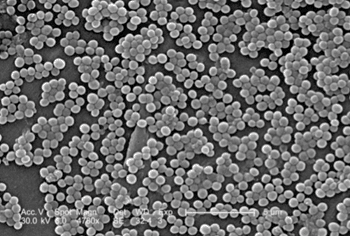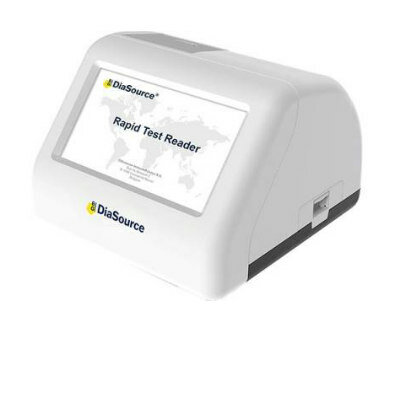Antitoxin Vaccine Protects Laboratory Animals Against Staphylococcus Infection
By LabMedica International staff writers
Posted on 31 Dec 2013
A vaccine comprising a cocktail of superantigens and cytolysins protected rabbits challenged with virulent strains of Staphylococcus aureus while vaccines based on bacterial surface antigens failed to protect the animals or actually increased the severity of the infection.Posted on 31 Dec 2013
Superantigens (SAgs) are a class of antigens that cause nonspecific activation of T-cells resulting in polyclonal T-cell activation and massive cytokine release. SAgs are produced by pathogenic microbes (including viruses, mycoplasma, and bacteria) as a defense mechanism against the immune system. Compared to a normal antigen-induced T-cell response where 0.0001–0.001% of the body’s T-cells are activated, SAgs are capable of activating up to 25% of the body’s T-cells.

Image: Scanning electron micrograph (SEM) showing numerous clumps of methicillin-resistant Staphylococcus aureus (MRSA) magnified 4,780x (Photo courtesy of the CDC - Centers for Disease Control and Prevention).
Previous attempts to vaccinate laboratory animals with bacterial cell-surface proteins failed to protect them and, in some cases, actually increased the severity of the infection.
Using a different approach, investigators at the University of Iowa (Iowa City, USA) vaccinated rabbits with a cocktail of wild-type toxins or toxoids produced and secreted by S. aureus, which was made up of combinations of superantigens (toxic shock syndrome toxin-1, enterotoxins B and C, and enterotoxin-like X) and cytolysins (alpha, beta, and gamma-toxins). Other rabbits were passively vaccinated with hyperimmune serum taken from some of the actively vaccinated animals. The rabbits were challenged with multiple strains of S. aureus, both methicillin-sensitive and methicillin-resistant (MRSA).
Results published in the December 19, 2013, online edition of the Journal of Infectious Disease revealed that vaccination against secreted superantigens and cytolysins resulted in protection of 86/88 rabbits when challenged intrapulmonary with nine different S. aureus strains, compared to only 1/88 nonvaccinated animals.
Not only did the vaccine protect the animals from dying but also seven days after vaccination pathogenic bacteria could not be detected in the animals' lungs.
Passive immunization studies demonstrated that production of neutralizing antibodies was critically involved in the protective mechanism.
"Our study suggests that vaccination against these toxins may provide protection against all strains of Staphylococcus," said senior author Dr. Patrick Schlievert, professor of microbiology at the University of Iowa. "If we can translate this finding into an effective vaccine for people it could potentially prevent millions of cases of serious and milder skin and soft tissue infections yearly."
Related Links:
University of Iowa







 Extraction or Purification Kit.jpg)






